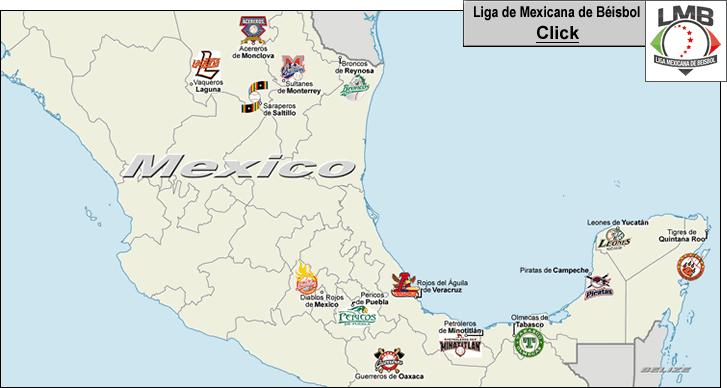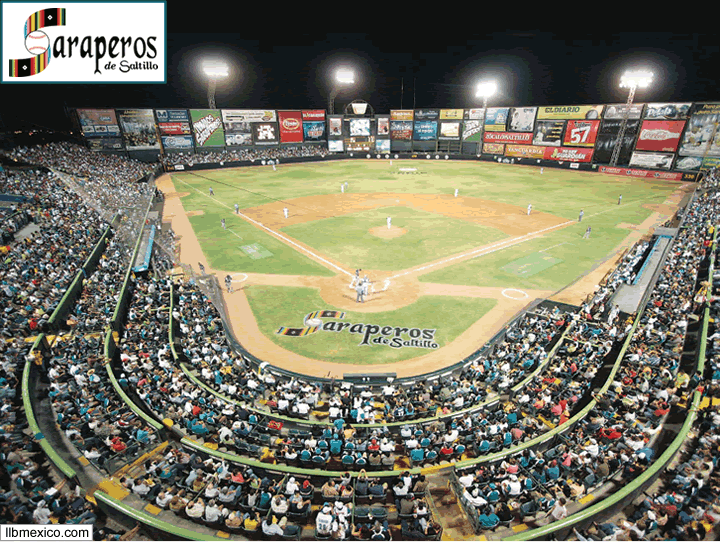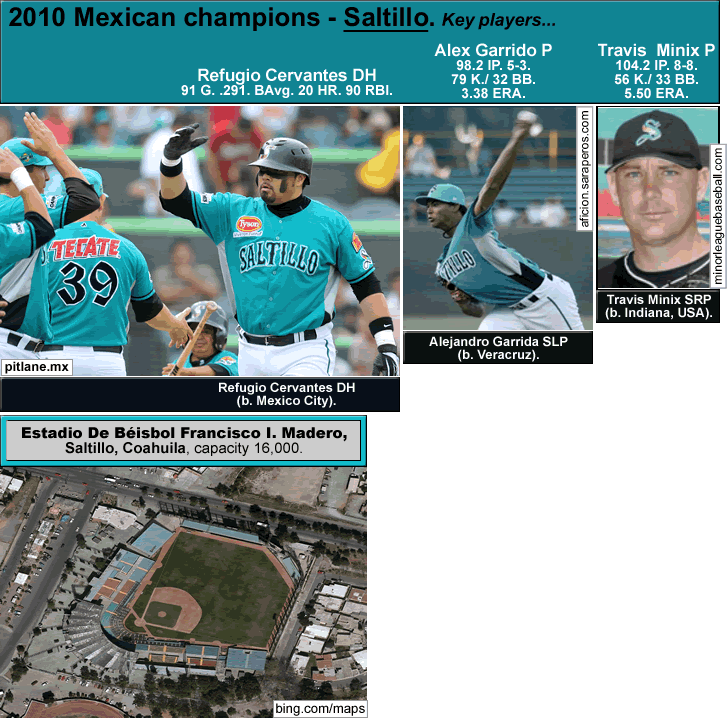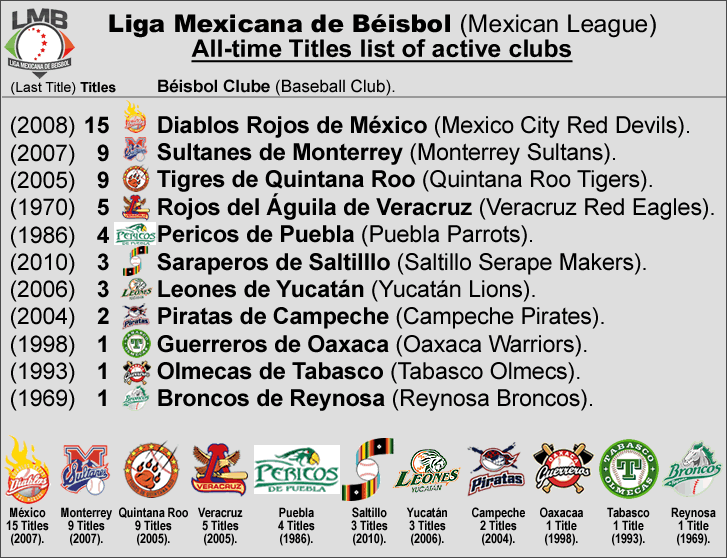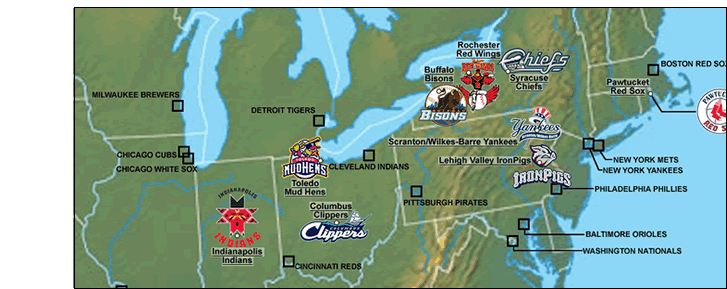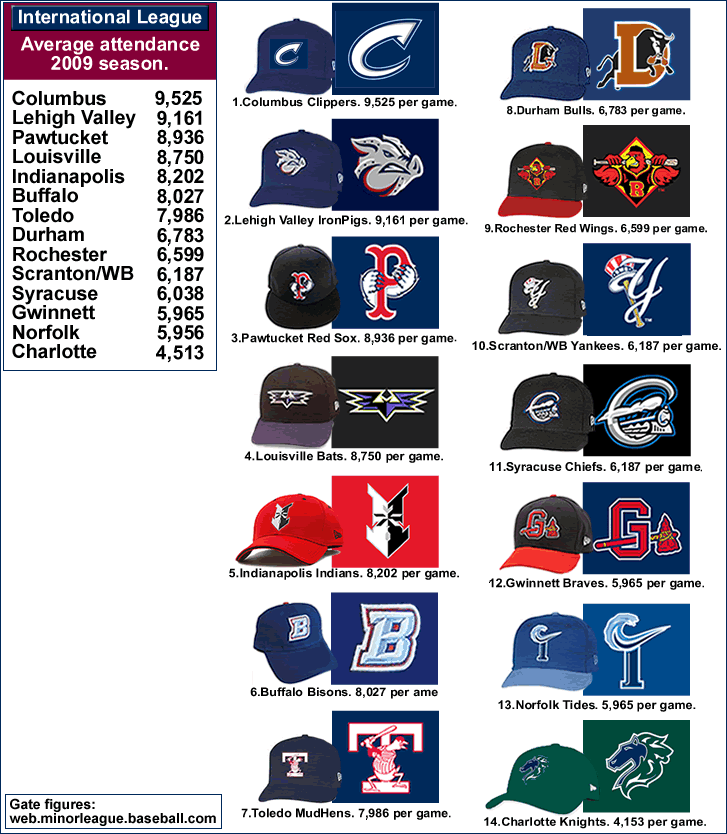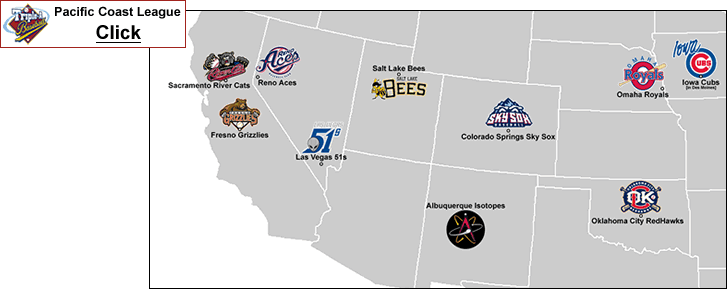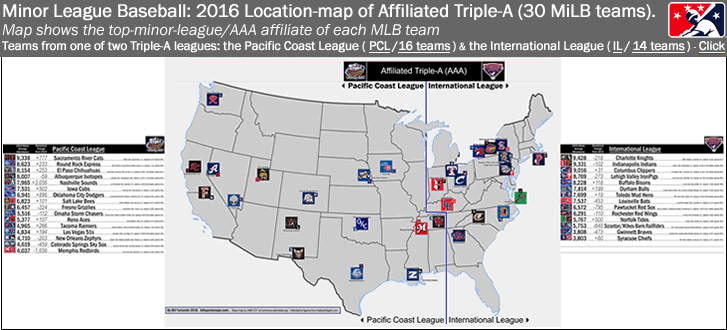
Affiliated Triple-A baseball: location-map of 2 leagues, the Pacific Coast League (PCL) & the International League (IL), w/ 2015 attendances and MLB-team-affiliations noted
…
…
By Bill Turianski on 29 May 2016; twitter.com/billsportsmaps.
Links…
-Official site of the International League…Triple-A International League [MiLB].
-International League/current teams (en.wikipedia.org).
-Official site of the Pacific Coast League…Triple-A Pacific Coast League [MiLB].
-Pacific Coast League (en.wikipedia.org).
-2015 Affiliated Attendance by League… 2015 Affiliated Attendance by League (by Kevin Reichard at ballparkdigest.com).
-2015 Affiliated Attendance by Average.. 2015 Affiliated Attendance by Average (by Kevin Reichard at ballparkdigest.com).
-Article on Norfolk Tides’ bizarre new bright-green/orange/black/turquoise/grey uniforms…Tides Unveil New Creative Identity) [article, with 5 disparaging comments by angry Norfolk fans] (milb.com/news).
-Top 100 MiLB caps in 2014 [fan vote]…Clash of the Caps – Who has the best caps in the minor leagues? [2014 season] [#1: El Paso Chihuahuas]…(milb.com/milb/fans/caps).
-Top 100 MiLB caps in 2015 [fan vote]…Clash of the Caps – Who has the best caps in the minor leagues? [2015 season] [#1: Daytona Tortugas]…(milb.com/milb/fans/caps).
-
Affiliated Triple-A minor league baseball (MiLB):
Location-map of the 2 leagues, the Pacific Coast League (PCL) & the International League (IL) -
with 2015 attendances and MLB-team-affiliations noted
By Bill Turianski on 11 April 2015; twitter.com/billsportsmaps.com.
Elements of the map page…
The location-map shows the top-minor-league/AAA affiliate of each Major League Baseball team – 30 teams from one of two Triple-A leagues: the Pacific Coast League (PCL) & the International League (IL). On the map, the teams are shown with their home-cap-crest and the cap-crest of their MLB parent-club. Flanking the map are the 2015 attendances of the teams, with the PCL teams on the far left of the map, and the International League teams on the far right. Listed in both the PCL & IL league-charts are:
1). 2015 Attendance figures (home regular season average attendance),
2). Change in crowd-size from previous season (numerical change from 2014),
3). Ballpark name,
4). Ballpark city-location,
5). Ballpark capacity (total capacity and seated capacities),
6). Year the ballpark was opened.
Finally, a line has been inserted on the map, running north from the Florida panhandle, through the middle of Tennessee, then jogging west in Kentucky, and then running north again between Indiana and Illinois. This line denotes the division between the PCL-territory (to the west of the line), and the IL-territory (to the east of the line). In case you are wondering, the furthest-east PCL team – the Nashville Sounds, is slightly west of the furthest-west IL team – the Indianapolis Indians. In other words, there is no over-lap between the 2 leagues’ territorial ranges. But just barely.
There are actually 3 Triple-A leagues within Minor League Baseball (which is run by Major League Baseball)…
There are 3 Triple-A leagues: the International League, the Pacific Coast League, and the Mexican League. The International League and the Pacific Coast League are comprised of pro ball clubs at the Triple-A level which have an affiliation with one of the 30 Major League Baseball teams. But the Mexican League is comprised of pro ball clubs at the Triple-A level without any affiliations to MLB teams. {To see my map-and-post on the 2015 Mexican League, click on the following, Mexico: Liga Mexicana de Béisbol (LMB) (Mexican League), location-map/attendance-map (2014 figures), with active-clubs titles list.}
…
The International League (IL)…
-International League/current teams (en.wikipedia.org).
-Baseball-reference.com/BR Bullpen blog/International League (baseball-reference.com/bullpen).
The International League was established in 1884, with the modern-day International League re-established in 1912. As it says at the Baseball-reference.com blog, …”The “international” in the name was due to the league having teams in Toronto and Montréal for decades.”…{see this}. Currently [2016], the IL has 14 teams in 3 divisions. The IL spans the Northeast (6 teams), the South Atlantic Seaboard (4 teams), the eastern part of the Upper Midwest (3 teams), and the south-central Ohio River Valley (1 team). In 2015, the IL continued to be the highest-drawing minor league, averaging 7,199 per game (down 70 per game, from the 7,269 per game the IL averaged in 2014).
The oldest team in the IL is the Rochester Red Wings…
The Red Wings, of Rochester, New York, have been an affiliate of the Minnesota Twins since 2003, and have existed as a pro ball club in Rochester – continuously – since 1899 {source: baseball-reference.com/[city, Rochester NY]}. Along with the Toledo Mud Hens and the Syracuse Chiefs, the Rochester Red Wings are [tied for being the] second biggest pro sports team in the USA which is community-owned (the biggest community-owned team in the USA is, of course, the Green Bay Packers of the NFL)/{sources: en.wikipedia.org/wiki/List_of_fan-owned_sports_teams#Baseball ; Rochester Community Baseball}. The Rochester Red Wings are tied with the Columbus Clippers (established 1977) for the most Governor’s Cup International League titles – 10. Columbus, a Cleveland Indians affiliate since 2009, won the 2015 International League title (their 3rd IL title in 6 years). But the Governor’s Cup title was established in 1933 as the trophy for the IL’s then-newly-established playoffs {see this, Governor’s Cup}. So if you count all International League titles, starting in 1912 [when the Eastern League (I) changed its name to the International League], Rochester has won 14 IL titles (and 20 minor league baseball titles, overall). Rochester’s last IL title was in 1997.
The highest drawing team in the IL these days is the Charlotte Knights…
The Charlotte Knights have basically tripled their fan-base ever since leaving their inadequate ballpark that was situated way out of town. That ballpark was about 19 miles south of the Charlotte, North Carolina city center – and was actually out-of-state, in Fort Mill, South Carolina. In 2013, the Knights drew a league-worst 3.0 K per game at that in-the-middle-of-nowhere ballpark. Now (since 2014), the Knights play in a sweet new 10.2 K-capacity ballpark in downtown Charlotte, which is called BB&T Ballpark (Charlotte) {see illustration below}, and the Charlotte Knights pack ‘em in to the tune of 9.4 K per game. That has made the Charlotte Knights (an affiliate of the Chicago White Sox) the highest-drawing minor league team in all of the USA, Canada, and Mexico {see MiLB 2015 attendance figures at the links section at the top of this post}. The other high-drawing teams in the International League are the Indianapolis Indians (a Pittsburgh Pirates affiliate) and the aforementioned Columbus Clippers, both of whom draw above 9 K; while the Lehigh Valley IronPigs [of Allentown, PA] (a Philadelphia Phillies affiliate), and the Buffalo Bisons (a Toronto Blue Jays affiliate) both draw above 8 K.
Below: BB&T Ballpark (Charlotte). Home of the Charlotte Knights (the Triple-A affiliate of the Chicago White Sox).
Best-drawing team in the IL & Best attendance in all of minor league baseball in 2015 (best of all 176 MiLB teams which record attendance)…
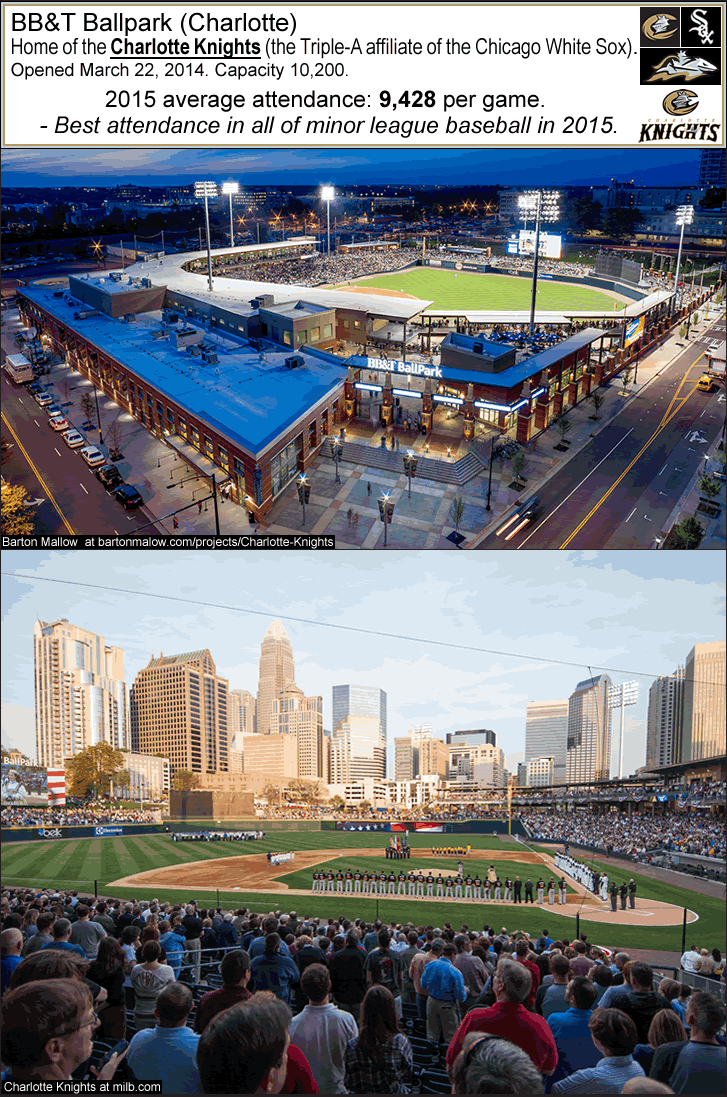
Photo and Image credits above – Logos from sportslogos.net/[Charlotte Knights]. Exterior roof-top view of stadium, photo by Barton Mallow [architect] at bartonmalow.com/projects/Charlotte-Knights. Interior shot of ballpark with downtown Charlotte skyline in the background, photo by Charlotte Knights at milb.com/[Charlotte Knights/tickets].
…
The Pacific Coast League (PCL)…
-Pacific Coast League/current teams (en.wikipedia.org).
-Baseball-reference.com/BR Bullpen blog/Pacific Coast League (baseball-reference.com/bullpen).
The Pacific Coast League was established in 1903. The PCL currently [2016] has 16 teams in 4 divisions within 2 conferences. The PCL spans not only the Pacific Coast but the entire Western United States (that whole area of the continental USA which is west of the Mississippi River) – plus 3 teams east of the Mississippi: one in New Orleans and two in Tennessee. The reason for the vast geographical spread of the Pacific Coast League is that, in 1997, the PCL absorbed 5 teams from the defunct American Association, which was Midwestern-US-based, and was the third Triple-A affiliated league back then. (Here are the 5 former-American-Association-teams that were absorbed into the PCL in 1997: Iowa Cubs, Nashville Sounds, New Orleans Zephyrs, Oklahoma City RedHawks [now nicknamed the Dodgers], Omaha Royals [now nicknamed the Storm Chasers].) In 2015, the PCL continued to be the second-highest-drawing minor league, averaging 6,508 per game (up 223 per game, from the 6,285 per game the PCL averaged in 2014). The PCL title-winner last year [2015] was the Fresno Grizzlies, who are a Houston Astros affiliate.
The team with the most PCL titles no longer exists – that was the San Francisco Seals, who won 13 PCL titles before the team moved on (to Phoenix, AZ) after the 1957 season, to make way for big league baseball in the Bay Area, when the New York baseball Giants moved from New York City to become the San Francisco Giants in 1958.
Here is a small map that I put together in 2009 which shows the old, Golden-Age/early 1950s Pacfic Coast League…
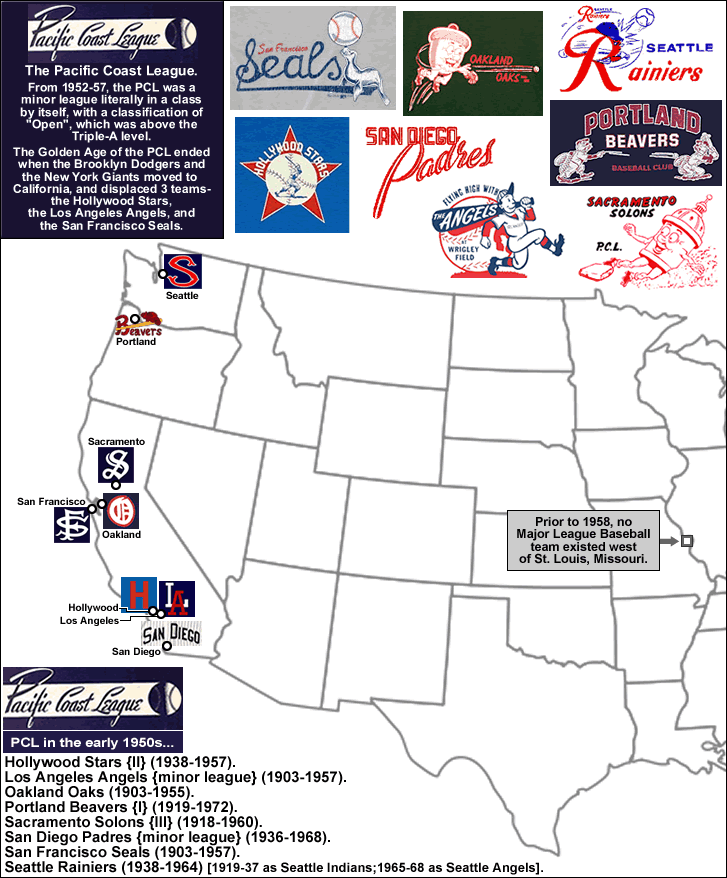
Original source of image above – [PCL, 2009 map (incl. Golden Age of PCL/1950s map).] (billsportsmaps.com/MiLB Triple A)
The oldest city-location in the PCL is in Sacramento, California…
Sacramento’s first PCL team was in 1903, with several franchise-shifts since then; the current ball club there moved from Vancouver, BC, Canada to Sacramento in 2000, becoming the River Cats. The Sacramento River Cats, an affiliate of the nearby San Francisco Giants, are perennially the highest-drawing PCL team, and were again in 2015, drawing 9.3 K per game. The other high-drawing teams in the PCL are the Round Rock Express [of Greater Austin, TX] (a Texas Rangers affiliate), the El Paso Chihuahuas [est. 2014] (a San Diego Padres affiliate), and the Albuquerque Isotopes (a Colorado Rockies affiliate). [Side-note: the Albuqueque Isotopes are (brilliantly) named after the fictional ball club which moved from Springfield to Albuquerque, in a famous 2001 episode of The Simpsons/ see this article from Telegraph.co.uk, from May 2015 by Rebecca Hawkes: The Simpsons: 27 times real life echoed the show/ and see #19 there: 'When the Albuquerque Isotopes became a real baseball team'.] Those 3 teams – Round Rock Express, El Paso Chihuahuas, and Albuquerque Isotopes – all drew above 8 K last season [2015]. A team that drew very close to 8 K last year was the Nashville Sounds, who drew 7.9 K (and increased their crowd-size by over 3 thousand per game), thanks to their brand-new 10-K-capacity ballpark in the downtown of the Music City, First Tennessee Park.
Below: Raley Field. Home of the Sacramento River Cats (the Triple-A affiliate of the San Francisco Giants).
Best-drawing team in the PCL & Third-best attendance in all of minor league baseball in 2015 (3rd-best of all 176 MiLB teams which record attendance)…
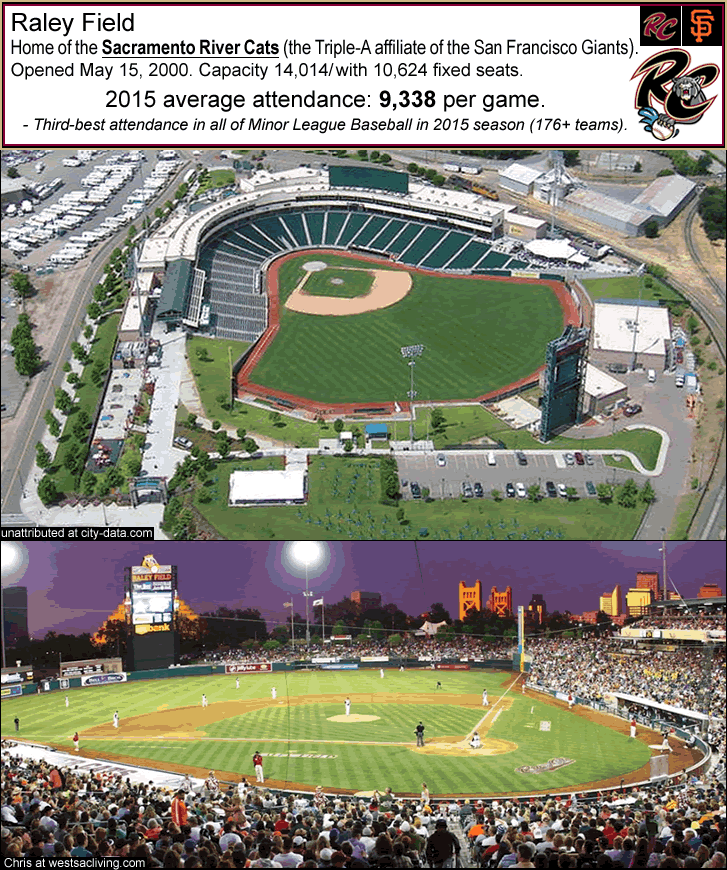
Photo and Image credits above – Logos from: sportslogos.net/[Sacramento River Cats]. Aerial view of stadium, photo unattributed at city-data.com. Interior/night-time view of a full house at Raley Field, photo by Chris at westsacliving.com/[blog article on visiting Raley Stadium]
___
Thanks to BallparkDigest.com, for attendance figures, 2015 Affiliated Attendance by League (ballparkdigest.com).
Thanks to the contributors at:
-Pacific Coast League (en.wikipedia.org);
-International League (en.wikipedia.org).
Thanks to AMK1211 for blank map of USA, ‘File:Blank US Map with borders.svg”>File:Blank US Map with borders.svg‘ (commons.wikimedia.org).
Thanks to Rochester Red Wings, for photo of home cap crest, here (redwings.milbstore.com/store).
